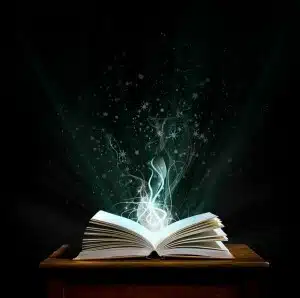Ahhh, to savor the power of a good story, that is sweet indeed. But how does a non-fiction writer tap into the memorable power of a well-told story? Let’s explore this together through this illustration…
Once long ago on a windswept hilltop, a restless boy—almost in his teen years—looked across the valley, his eager eyes searching for news. He spied a column of weary travelers hiking slowly for their heavy burden. The hunt was successful.
The boy raced down the slope, his hair flying in the wind. He ran straight to the head of the column into the iron arms of his marching father.
“Tell me about the hunt!” he demanded eagerly. “I want to know everything!”
“Patience, young one. You and the rest of the clan will hear disturbing news tonight by firelight when wounds are patched, bellies are full, and hunters’ blood has cooled.”
 I’ll bet you want to know what happens next, right?
I mean, come on! It’s human nature. Curiosity burns inside you, like a prehistoric bonfire.
Who is this boy? What kind of game did the warriors hunt? How did the hunters get wounded? What will become of the clan, what is the “disturbing news”?
These questions naturally burn inside us all. We crave stories. In fact, our need for stories is part of our DNA.
This was the conclusion of Joseph Campbell, the world famous scholar of Mythology and chronicler of the Hero’s Journey in his book, The Hero With a Thousand Faces.
Campbell told us that the Hero’s Journey, or the Mono-Myth, has been told in stories all over the world throughout the ages. Stories from every continent can be broken down into the same basic structure.
Whether it’s Aesop’s Fables, the Brothers Grimm, Hans Christian Andersen, or Matthew, Mark, Luke & John, we thrive on the power of stories. We learn and grow through their messages, and we smile with satisfaction once the tale is told.
I’ll bet you want to know what happens next, right?
I mean, come on! It’s human nature. Curiosity burns inside you, like a prehistoric bonfire.
Who is this boy? What kind of game did the warriors hunt? How did the hunters get wounded? What will become of the clan, what is the “disturbing news”?
These questions naturally burn inside us all. We crave stories. In fact, our need for stories is part of our DNA.
This was the conclusion of Joseph Campbell, the world famous scholar of Mythology and chronicler of the Hero’s Journey in his book, The Hero With a Thousand Faces.
Campbell told us that the Hero’s Journey, or the Mono-Myth, has been told in stories all over the world throughout the ages. Stories from every continent can be broken down into the same basic structure.
Whether it’s Aesop’s Fables, the Brothers Grimm, Hans Christian Andersen, or Matthew, Mark, Luke & John, we thrive on the power of stories. We learn and grow through their messages, and we smile with satisfaction once the tale is told.
 I’ll bet you want to know what happens next, right?
I mean, come on! It’s human nature. Curiosity burns inside you, like a prehistoric bonfire.
Who is this boy? What kind of game did the warriors hunt? How did the hunters get wounded? What will become of the clan, what is the “disturbing news”?
These questions naturally burn inside us all. We crave stories. In fact, our need for stories is part of our DNA.
This was the conclusion of Joseph Campbell, the world famous scholar of Mythology and chronicler of the Hero’s Journey in his book, The Hero With a Thousand Faces.
Campbell told us that the Hero’s Journey, or the Mono-Myth, has been told in stories all over the world throughout the ages. Stories from every continent can be broken down into the same basic structure.
Whether it’s Aesop’s Fables, the Brothers Grimm, Hans Christian Andersen, or Matthew, Mark, Luke & John, we thrive on the power of stories. We learn and grow through their messages, and we smile with satisfaction once the tale is told.
I’ll bet you want to know what happens next, right?
I mean, come on! It’s human nature. Curiosity burns inside you, like a prehistoric bonfire.
Who is this boy? What kind of game did the warriors hunt? How did the hunters get wounded? What will become of the clan, what is the “disturbing news”?
These questions naturally burn inside us all. We crave stories. In fact, our need for stories is part of our DNA.
This was the conclusion of Joseph Campbell, the world famous scholar of Mythology and chronicler of the Hero’s Journey in his book, The Hero With a Thousand Faces.
Campbell told us that the Hero’s Journey, or the Mono-Myth, has been told in stories all over the world throughout the ages. Stories from every continent can be broken down into the same basic structure.
Whether it’s Aesop’s Fables, the Brothers Grimm, Hans Christian Andersen, or Matthew, Mark, Luke & John, we thrive on the power of stories. We learn and grow through their messages, and we smile with satisfaction once the tale is told.
